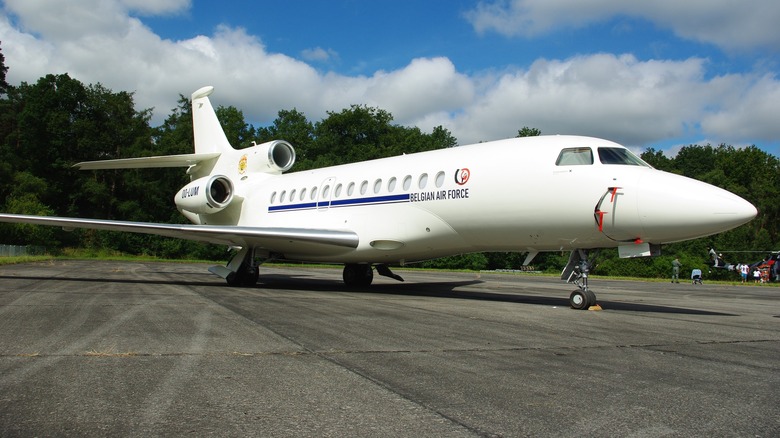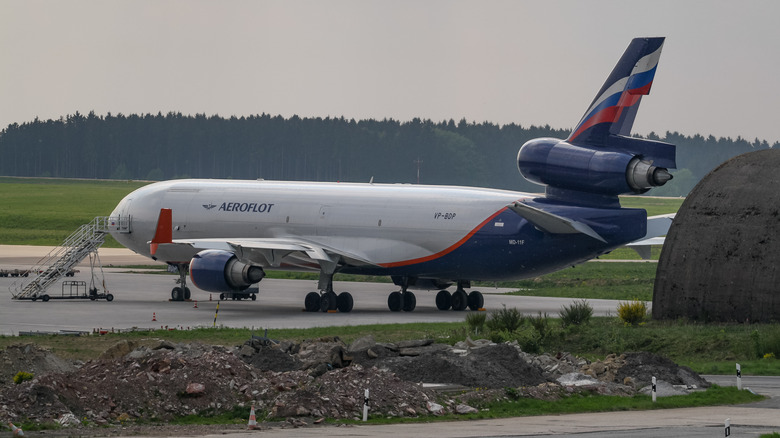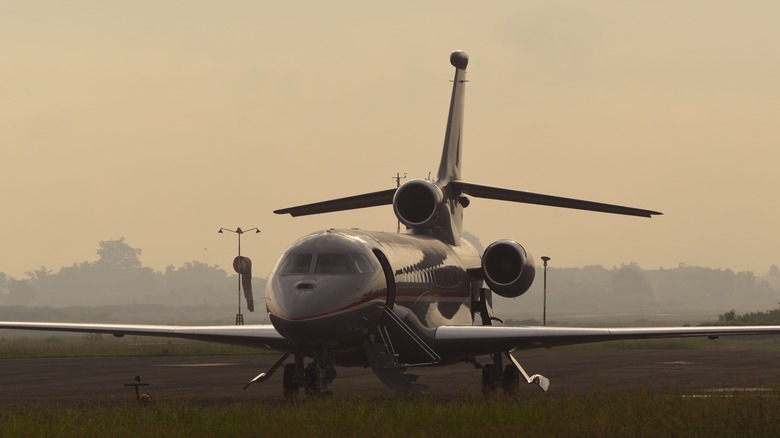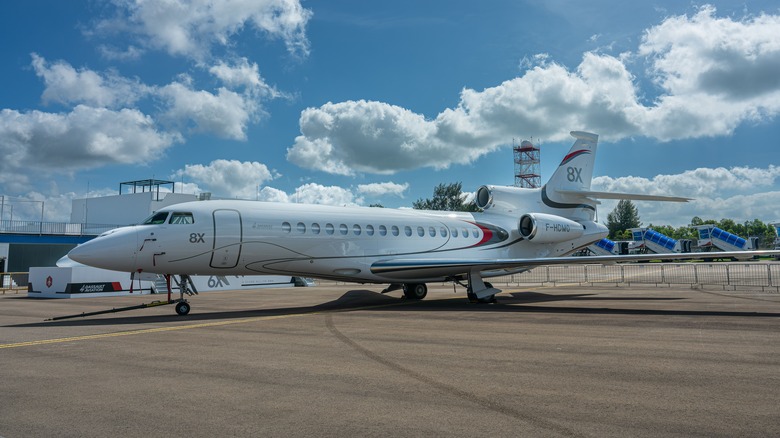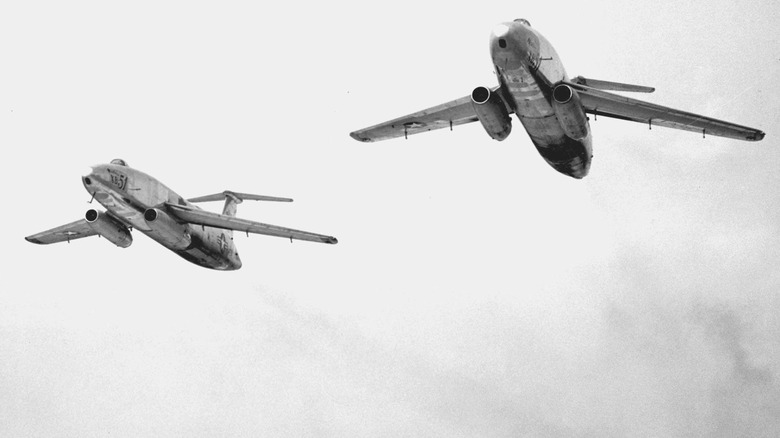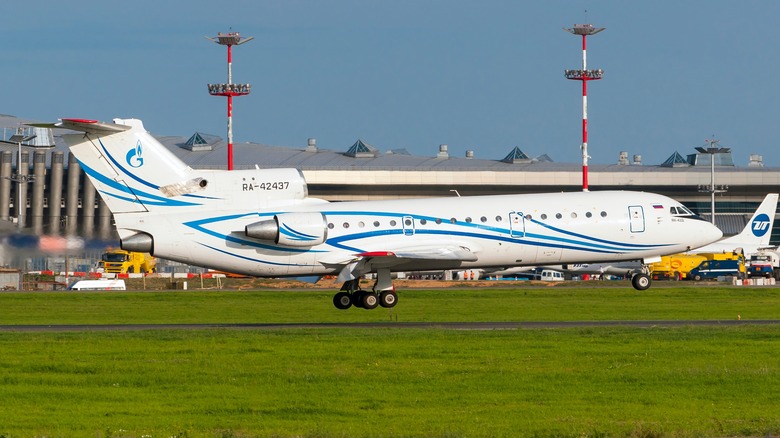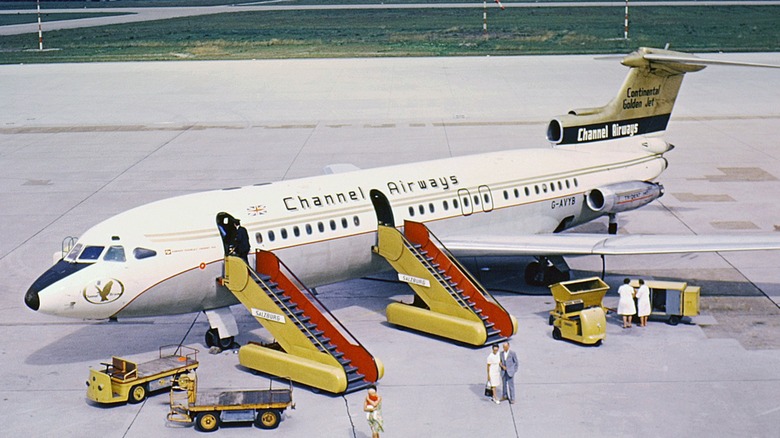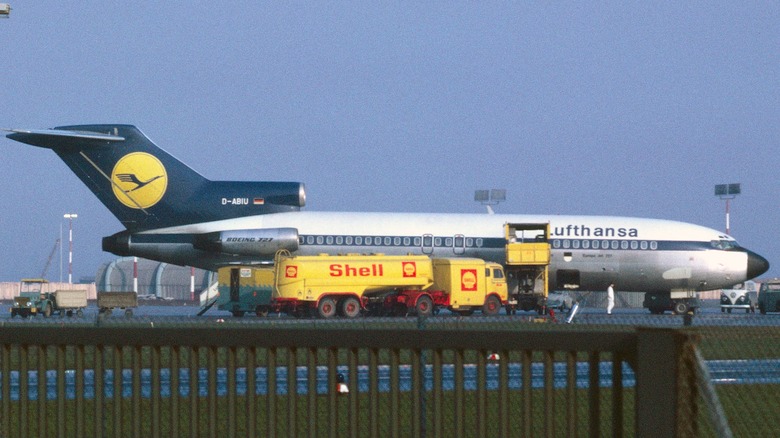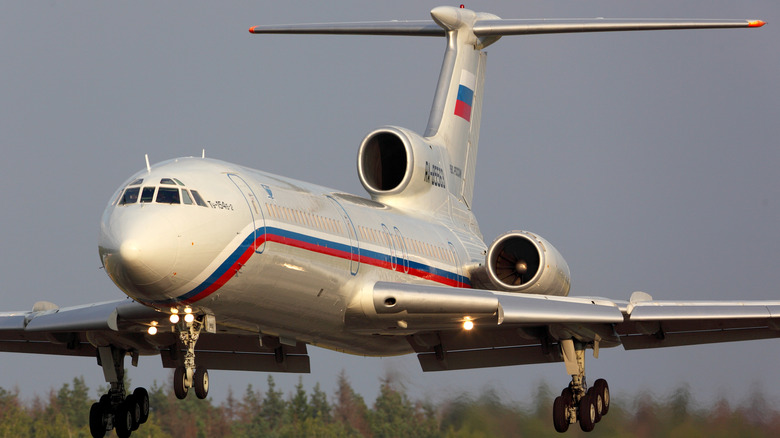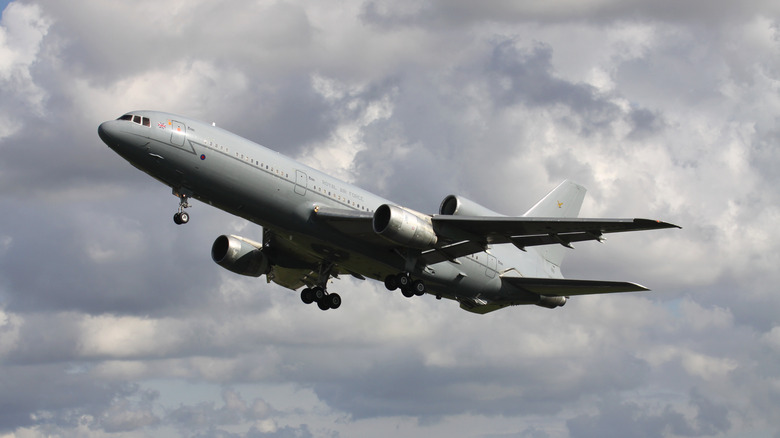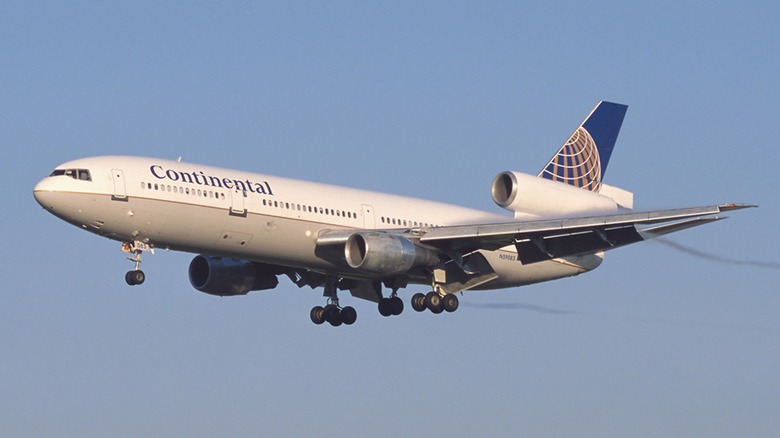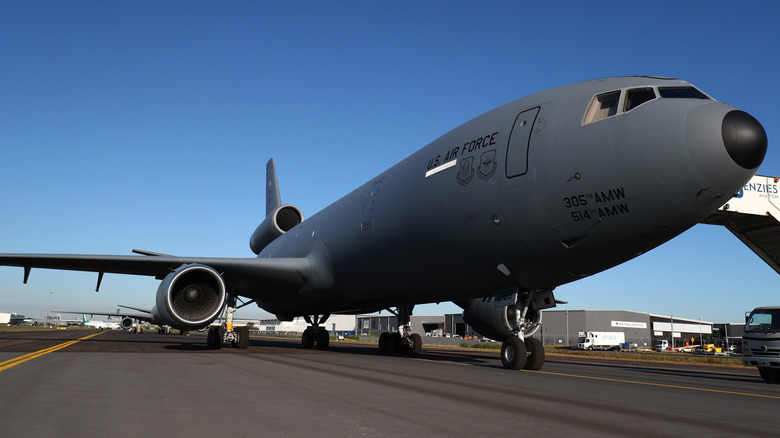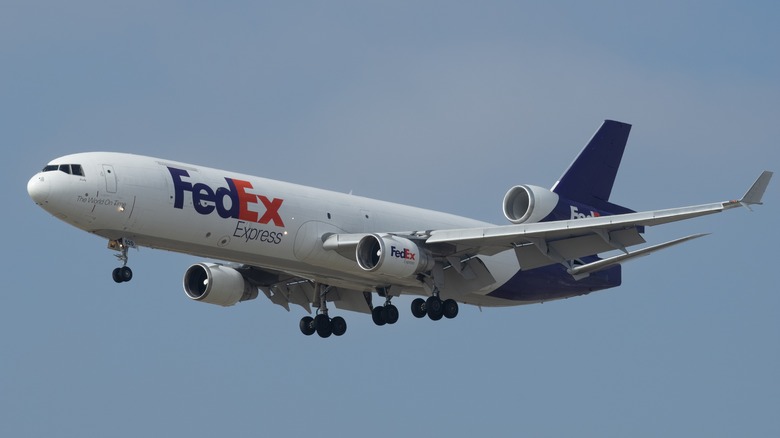10 Of The Biggest Trijets To Ever Grace The Skies
We've come a long way since the age of propellor-based aviation. Sure, there are still plenty of single turboprop engine airplanes, but these days most planes — especially the big ones — require more thrust. Today, commercial craft generally use jet engines, and one might assume that the more engines a plane has, the more lift it will get, right? Not quite.
Currently, twinjet engines dominate the skies, but before they did, plenty of planes used the trijet design. These vehicles came in many shapes and sizes — technically, even the highly experimental flying saucer Avrocar could be considered a trijet because it used three turbojet engines. However, most trijets sat on the opposite end of the size spectrum. Most were far from the largest planes in the world, but some got massive.
Here are 10 of the biggest trijet planes ever flown. This list will only focus on planes that actually flew — crafts that never made it out of the concept phase don't count.
What is a trijet?
As its name suggests, a trijet is a plane with three jet engines. The Avrocar notwithstanding, the layout of these engines generally came in two forms: Either two jets sat under the wings and one nestled on the tail, or all three huddled up around the rear with two on the fuselage and one on the tail. The latter design shifted the plane's center of gravity, and actually increased fuel efficiency.
Trijets were more fuel efficient than quadjets because three engines use less fuel than four, they were cheaper to produce as well, given the one fewer engine reqiured. However, the trijet design wasn't without its share of drawbacks. The new center of gravity helped with fuel efficiency, but made the planes harder to control. Moreover, since the third engine was part of the tail and used a unique design known as an S-duct, installation was much more difficult than your standard wing-mounted engine.
The first trijet plane was the Tupolev Tu-73, which flew in 1947. However, that was a prototype bomber that never made it to mass production. The trijet didn't truly catch on until the early 1960s, as that period saw the release of the Hawker Siddeley Trident and the Boeing 727 (more on those later).
Why we don't see trijets anymore
Trijets effectively replaced quadjets when they demonstrated to be more, well, more effective. And then history repeated itself.
Just as trijets were more fuel efficient and cheaper than quadjets, twinjets proved more fuel efficient and cheaper than trijets. In addition, advancements in technology made twinjet engines more reliable than trijet engines. Those were the only reasons, but that was plenty — when you're in the transportation business (or any for that matter), you want each subsequent generation of product to be cheaper and better than the last.
However, trijets aren't completely extinct (nor are quadjets, but we're not here to talk about them). The majority of trijets are currently commercial liners that have been repurposed for cargo transportation. However, these planes are a still dying breed because their respective manufacturers don't produce them anymore. When they inevitably fail, they will be replaced by more modern twinjet alternatives. One of the only companies that still builds trijet planes is Dassault Falcon, which specializes in personal jets such as the Falcon 8x and the 900LX.
Dassault Falcon 8X
As we just stated, Dassault Falcon is one of the few, if not only, companies still in the trijet plane building business. Each of Dassault Falcon's jets is designed primarily for personal, business, and government flights. The cabins are roomy and furnished with tables, beds, and even a minibar. And since Dassault Falcons are built with modern technologies, these planes include services such as high-speed inflight Wi-Fi. Although. Some Falcon planes are alternatively built for signals intelligence (SIGINT) and med-evac flight missions.
Currently, the Dassault Falcon 8X is the company's largest trijet product. The 8X is shaped like your typical commercial airliner with a length of 80 feet, 4 inches, a height of 26 feet, 1 inch, and wings that stretch 86 feet, 4 inches. While the cabin is roomy, it can only fit up to 16 people. Once loaded up on passengers, pilots, fuel, and luggage, the Falcon 8X can weigh as much as 73,000 pounds.
Martin XB-51
Unlike other planes on this list, the Martin XB-51 was a military attack aircraft. The plane was designed at the end of World War II and originally intended to serve in bombing runs. While test pilots praised the two prototypes for their accuracy and maneuverability, the XB-51 didn't make the cut. Instead, evaluators decided to approve the Martin B-57 Canberra for service. While the XB-51 never saw any action, for the next few years, the U.S. Air Force kept its prototypes around for general research. Unfortunately, both were lost to tragic crashes in 1952 and 1953.
Because the XB-51 was a military bomber, its design was sleek and thin, almost pen-shaped. The plane stretched 85 feet, 1 inch from tip to tail with swept-back wings that spanned 53 feet, 1 inch and had a total area of 548 square feet. The cockpit could only fit two people, and the majority of the plane's body stored fuel and bombs. Fresh off the production floor, the XB-51 weighed 30,906 pounds, but once completely fueled and armed, it could weigh as much as 62,452 pounds.
Yakovlev Yak-42
The Soviet Union's Tupolev Tu line of planes saw a long and successful life (again, the Tupolev Tu-73 was the first trijet plane ever), but the U.S.S.R. eventually had to start replacing them. The Yakovlev Yak-42 was a short range plane designed to succeed many Soviet airliners, including the Tupolev Tu-134 and the turboprop-powered Antonov An-24. The Yak-42 was allegedly the first Soviet plane to use true turbofans and could fit up to 120 passengers. Engineers also built several iterations. These included the Yak-42D, which had an improved flight range, and the Yak-42T, which served as a freight jet instead of a commercial passenger plane. One special version, the Yak-142, was built with electric flight displays instead of the then-standard electromechanical displays.
Regardless of alterations, all Yak-42s shared the same basic external dimensions. The plane measured 119 feet, 4 inches long and 32 feet, 3 inches high. The wingspan stretched 114 feet, 5 inches, and the total wing area measured 1,614 square feet. However, different configurations affected the plane's weight. Yak-42s with 104 seats weighed 76,058 pounds when empty, whereas 42s with 120 seats weighed 76,092 pounds. And while a normal Yak-42 could total as much 125,660 pounds on takeoff, the 42D improved that limit to 126,765 pounds.
Hawker Siddeley Trident
The Tupolev Tu-73 might have been the first trijet to ever fly, but the Hawker Siddeley Trident was trijet to make commercial flights. The Trident made its maiden liftoff in 1962, but it didn't actually ferry passengers until 1964. This plane also had more going for it than just a three-engine design. The Trident was the first airliner capable of a fully blind automatic landing (a landing made in complete darkness without even runway lights) thanks to a series of advanced avionics systems. Moreover, it utilized a proprietary Doppler system to report its position.
The Hawker Siddeley Trident was technically a series of airliners that came in a variety of dimensions. The largest measured 138 feet, 9 inches long and 27 feet high with a wingspan of 98 feet. When devoid of passengers, luggage, and fuel, the Trident weighed 73,200 pounds. While impressive in terms of size and performance, the Trident never lived up to its full potential, mostly because Boeing stole Hawker Siddeley's thunder by introducing its own trijet airliner.
Boeing 727
When people think about trijet planes, the Boeing 727 usually springs to mind, and for good reason. Pilots considered it one of the best commercial aircraft to fly, due to its speed and ease of landing. That latter point might clash with the public image (many passengers criticized its landings), but according to internal investigations, most issues were caused by human error, not flaws in the plane's design. The 727 was Boeing's only stab at the trijet design. The company quickly abandoned trijets for twinjets with the 737 and 757.
The Boeing 727 came in two flavors, the 727-100 and the 727-200 — three if you count the Advanced 727-200. The 727-200 series stretched 153 feet, 2 inches long with a total height of 34 feet, 11 inches. Regardless of version, all 727s flew aloft wings 108 feet long with a total area of 1,650 square feet. While some 727s had a maximum capacity of 134 seats, others could cram up to 155 passengers. While the 727-200 and Advanced 727-200 looked similar, they set themselves apart with performance that came at the cost of weight. When empty, the Advanced 727-200 weighed 100,700 pounds, but at takeoff, it could weigh as much as 209,500 pounds.
Tupolev Tu-154/155
Before the Yakovlev Yak-42 supplanted Tupolev Tu planes, Tupolev manufactured what was considered the workhorse of Soviet airlines, the Tupolev Tu-154. This mid-range airliner proved so reliable it remained in service from the mid-1960s to the mid-2000s. Tupolev even modified one Tu-154 into the Tu-155, which was physically identical to the Tu-154 except for its fuel source. This experimental conversion served as the world's first airborne testbed for alternative fuel sources such as hydrogen and liquid natural gas.
Like other airliners mentioned on this list, the Tupolev Tu-154 came in a variety of shapes and sizes. All Tu-154 variants were 157 feet, 6 inches long with a height of 37 feet, 5 inches and a wingspan of 123 feet, 2 inches. However, one model, the Tu-154M, boasted slightly bigger wings that covered 2,170 square feet (most Tu-154s had a wing area of 2,168 square feet). The Tu-154M also weighed more than other Tu-154s, coming in at 121,900 pounds when empty and 229,000 pounds at max capacity of 180 passengers.
Lockheed L-1011 Tristar
Much like the Hawker Siddeley Trident, the Lockheed L-1011 Tristar was ahead of its time and still failed. According to its manufacturers, the plane was "the first commercial airliner capable of flying itself from takeoff to landing." But the Tristar was more than just a technical marvel. Its passengers flew in the lap of luxury — many people likened their flights to staying in a hotel or cruise ship. Unfortunately, the Tristar might have been too impressive. Financial issues plagued Lockheed Martin, as well as the manufacturer of the Tristar's engines, Rolls Royce. As a result, the L-1011 Tristar was Lockheed Martin's final commercial airplane before the company shifted focus to military jets.
The L-1011 Tristar was a luxury airliner with multiple decks and an elevator to travel between them — in short, it was massive. The Tristar's length stretched a considerable 178 feet, 8 inches, and its height sat at 55 feet, 4 inches. As for the wings, they spanned an impressive 155 feet, 4 inches. Moreover, the L-1011 Tristar was able to fit a total of 250 passengers, and when ready for takeoff, the plane could weigh as much as 430,000 pounds.
McDonnell Douglas DC-10
The McDonnell Douglas DC-10 is one of the few trijets still in operation — sort of. The plane began service in 1971 as a long-range airliner, but its reputation was tarnished in May of 1979 by American Airlines Flight 191 — arguably the deadliest plane crash in history — and again in November of 1979 with another catastrophic crash, Air New Zealand's Flight TE901. While many air passengers have never forgotten these tragedies, the DC-10 has managed to move on somewhat. This plane ended its tenure of passenger transportation in 2014, but it still sees some use as a cargo freighter and aerial refueling platform. Although, those jets are technically classified as MD-10s and KC-10 Extenders (more on that one soon).
The McDonnell Douglas DC-10 came in three varieties: the DC-10-10, the DC-10-30, and the DC-10-40. The DC-10-10 was the longest, with a length of 182 feet, 3 inches, although the 10-30 and the 10-40 were almost as long at 181 feet, 7 inches and 182 feet, 2 inches, respectively. While the DC-10-10 had a height of 57 feet, 6 inches and a wingspan of 155 feet, 4 inches, the 10-30 and 10-40 shared a height of 57 feet, 7 inches and a wingspan of 165 feet, 4 inches. Despite these seemingly negligible differences, the DC-10-10 could weigh as much as 440,000 pounds, whereas the 10-30 and 10-40 could tip the scales at 555,000 pounds. Regardless of dimensions, all DC-10 planes could fit anywhere between 270 and 399 passengers.
McDonnell Douglas KC-10 Extender
How do you refill a plane when it's up in the air? This might sound like a silly question, but not all pilots have the luxury of refueling on a runway. When a plane needs its tanks topped up mid-flight, that's where aerial refueling tankers such as the McDonnell Douglas KC-10 Extender come into play. As previously stated, this plane is a McDonnell Douglas DC-10 modified to haul fuel and cargo. More importantly, engineers added a fly-by wire system to the KC-10 that lets it transfer fuel into a nearby airplane, hence the "Extender" in its name.
Since the KC-10 Extender is a modified DC-10, they share much of the same structural DNA. Like the DC-10, the KC-10 is 181 feet, 7 inches long with a wingspan of 165 feet, 4 inches. However, the plane's height increased to 58 feet, 1 inch, and it can weigh as much as 590,000 pounds. While the KC-10 has enough room to fit 75 passengers, its primary job is hauling cargo and fuel. It can fit up to 170,000 pounds of freight and 356,000 pounds of jet gas. The United States Air Force plans to retire all KC-10 Extenders by September 2024.
McDonnell Douglas MD-11
The McDonnell Douglas MD-11 was the successor to the McDonnell Douglas MD-10 — as previously stated, the MD-10 is a modified DC-10. For the MD-11, McDonnell Douglas focused on improvements such as higher engine efficiency and fuel economy, but the company also added extra storage space for cargo and carry-on luggage. Perhaps most important of all, McDonnell Douglas reworked the flight deck so the MD-11 could be flown by two pilots, whereas prior trijet planes required three. Despite technically improving fuel efficiency, the MD-11 didn't live up to McDonnel Douglas' expectations (or promises), and a few years after the plane first took flight Boeing bought McDonnell Douglas and moved forward with the plane's early retirement.
Since the MD-11 could fit more cargo than other aircrafts of the time, it had a size to match that claim to fame. The plane's length was 200 feet, 10 inches, with a height of 57 feet, 9 inches. Plus, the MD-11's wingspan stretched a total of 169 feet, 6 inches. When full, the plane weighed 610,000 pounds and could fit 248 passengers. One MD-11 variant, the MD-11F, was built to exclusively haul freight. Aside from a large cargo door for loading and unloading cargo, the MD-11F was physically identical to the standard MD-11.
